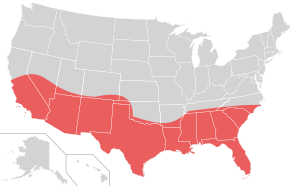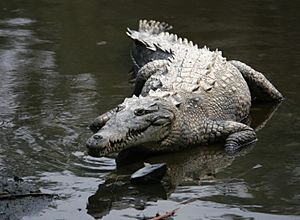Sun Belt facts for kids
 |
|
| Regional statistics | |
|---|---|
| Composition | |
| Demonym | Sun Belter |
| Population - Total - Density |
144,460,016 (2016 est.) |
| Largest city | Los Angeles (pop. 3,971,883, est. 2015) |
| Largest Metropolitan Area | Greater Los Angeles (pop. 18,679,763, est. 2016) |
The Sun Belt is a large area in the United States. It stretches across the southern parts of the country. You can find it from the Southeast to the Southwest. Another way to think of it is the area south of the 36th parallel line.
This region has many different climates. You can find deserts in states like California, Nevada, Arizona, New Mexico, Utah, and Texas. California also has a Mediterranean climate, which means warm, dry summers. Many states like Florida, Georgia, South Carolina, North Carolina, Texas, Louisiana, Mississippi, Alabama, Arkansas, and Tennessee have a humid subtropical climate. This means hot, humid summers and mild winters. South Florida even has a tropical climate, which is warm all year.
Since the 1960s, many people have moved to the Sun Belt. They come for the warm, sunny weather. Many older adults, called baby boomers, also move here to retire. The region also offers many new job opportunities. The invention of air conditioning made summers more comfortable. This allowed more factories and businesses to open in the Sun Belt.
Homes in the Sun Belt are often new and modern. They have open designs. There are many fun things to do all year round. Tourist cities like Las Vegas, Los Angeles, Atlanta, Houston, Miami, Myrtle Beach, New Orleans, Orlando, Palm Springs, Phoenix, San Diego, St. George and Tampa welcome visitors throughout the year.
What is the Sun Belt?
The Sun Belt includes the southern states of the U.S. These are Alabama, Arizona, Florida, Georgia, Louisiana, Mississippi, New Mexico, South Carolina, and Texas. It also covers about two-thirds of California and parts of North Carolina, Nevada, and Utah.
Some of these states are sometimes called the Sand States. These are Arizona, California, Florida, Nevada, and Texas. They get this name because they have many beaches or deserts.
Why is the Sun Belt Important?
The name "Sun Belt" was first used by a political writer named Kevin Phillips in 1969. By the early 1970s, the term was widely used for the southern third of the country. During this time, the Sun Belt became more important for the economy and politics. Power shifted from the Midwest and Northeast to the South and West.
Many things helped the Sun Belt grow. The warm climate was a big draw. Workers also moved from Mexico to the region. The farming industry also grew a lot. The warm weather helped farming. It also encouraged many retired people to move to places like Florida and Arizona.
Certain industries grew quickly in the Sun Belt. These included companies that make things for airplanes and space and for defense. The oil business also boomed. Companies liked that there were fewer labor unions in the region. This was because industries were newer here, starting in the 1930s to 1950s. Also, many military bases were nearby, and they bought a lot of these products.
The oil industry helped states like Texas and Louisiana become strong. Tourism grew in Florida and Southern California. More recently, high tech and new economy businesses have driven growth. These include technology companies. California, Florida, and Texas are now home to many of the largest companies in the U.S.
See also
 In Spanish: Cinturón del Sol para niños
In Spanish: Cinturón del Sol para niños


